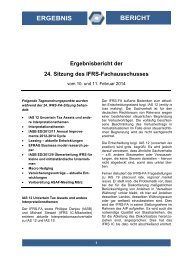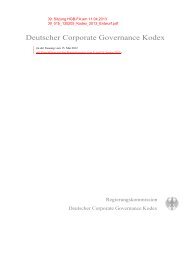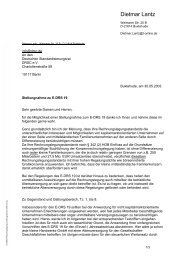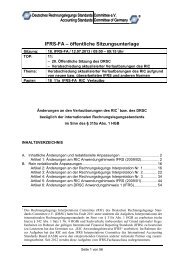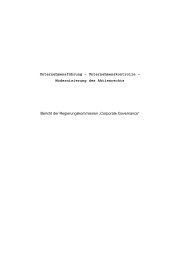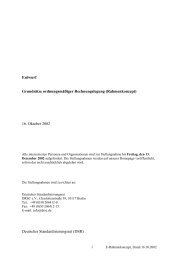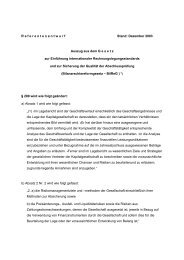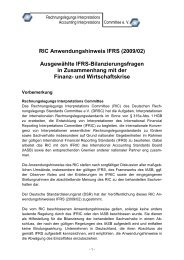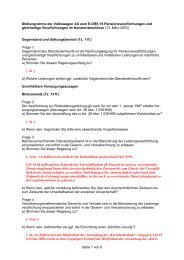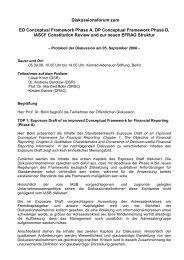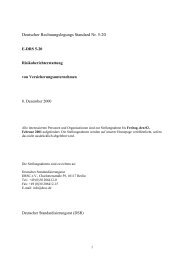Classification and Measurement: Limited Amendments to IFRS 9
Classification and Measurement: Limited Amendments to IFRS 9
Classification and Measurement: Limited Amendments to IFRS 9
You also want an ePaper? Increase the reach of your titles
YUMPU automatically turns print PDFs into web optimized ePapers that Google loves.
CLASSIFICATION AND MEASUREMENT: LIMITED AMENDMENTS TO <strong>IFRS</strong> 9 (PROPOSED AMENDMENTS TO <strong>IFRS</strong> 9 (2010))<br />
(b) address the interaction between the classification <strong>and</strong> measurement of<br />
financial assets <strong>and</strong> the accounting for insurance contracts liabilities;<br />
<strong>and</strong><br />
(c) increase comparability with the FASB’s tentative classification <strong>and</strong><br />
measurement model.<br />
BC18 Prior <strong>to</strong> the joint deliberations, the FASB had already decided <strong>to</strong> include a fair<br />
value through other comprehensive income measurement category in their<br />
tentative classification <strong>and</strong> measurement model for financial assets. This<br />
difference would have resulted in many financial assets being classified<br />
differently under <strong>IFRS</strong> <strong>and</strong> US GAAP if the FASB were <strong>to</strong> finalise those proposals,<br />
because <strong>IFRS</strong> 9 currently has only two measurement categories for financial<br />
assets.<br />
BC19 The boards jointly decided <strong>to</strong> propose that financial assets should be<br />
m<strong>and</strong>a<strong>to</strong>rily measured at fair value through other comprehensive income if,<br />
<strong>and</strong> only if, 16 they:<br />
(a) have contractual cash flow characteristics that give rise on specified<br />
dates <strong>to</strong> cash flows that are solely payments of principal <strong>and</strong> interest on<br />
the principal amount outst<strong>and</strong>ing (paragraph BC46); <strong>and</strong><br />
(b) are managed within the relevant business model (described in the<br />
following paragraph).<br />
BC20 The boards decided <strong>to</strong> propose that if the entity’s business model is <strong>to</strong> manage<br />
financial assets both <strong>to</strong> collect contractual cash flows <strong>and</strong> <strong>to</strong> sell, 17 financial<br />
assets managed within that business model should be measured at fair value<br />
through other comprehensive income (depending on their contractual cash<br />
flows). The IASB noted that the introduction of the fair value through other<br />
comprehensive income measurement category will also address the feedback of<br />
those interested parties who have questioned the appropriate classification of<br />
financial assets held within a business model in which assets are managed both<br />
in order <strong>to</strong> collect contractual cash flows <strong>and</strong> for sale. 18<br />
BC21 The IASB acknowledged that a third measurement category adds complexity <strong>to</strong><br />
<strong>IFRS</strong> 9. However, the IASB believes that, for some financial assets, measurement<br />
at fair value through other comprehensive income would reflect their<br />
performance better than measurement at either amortised cost or fair value<br />
through profit or loss, <strong>and</strong> that the complexity would be justified by the<br />
usefulness of the information provided.<br />
BC22 For a business model in which financial assets are managed both in order <strong>to</strong><br />
collect contractual cash flows <strong>and</strong> for sale, performance will be affected by both<br />
16 Subject <strong>to</strong> eligibility for, <strong>and</strong> election of, the fair value option (paragraph BC74).<br />
17 The business model assessment is made for a group of financial assets, <strong>and</strong> therefore an expectation<br />
<strong>to</strong> hold (some assets) <strong>and</strong> an expectation <strong>to</strong> sell (some assets) are not mutually exclusive.<br />
18 In contrast, the IASB is aware that other interested parties believe that the<br />
two-measurement-category classification approach in <strong>IFRS</strong> 9 results in an appropriate reflection of<br />
business models for managing financial assets. Some have stated this view within the context of<br />
interpreting a ‘hold <strong>to</strong> collect’ business model that is broader than the IASB intended (paragraphs<br />
BC13–BC16) <strong>and</strong> therefore might have a different view in the light of the clarifications <strong>to</strong> amortised<br />
cost.<br />
49<br />
� <strong>IFRS</strong> Foundation



